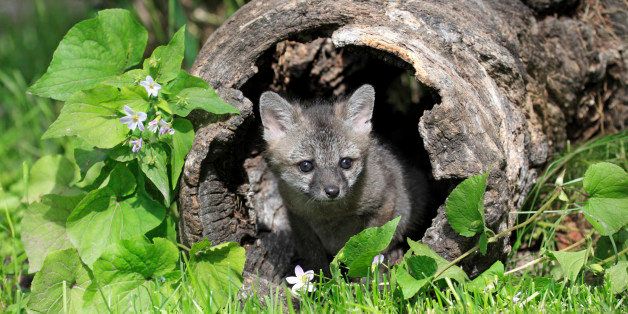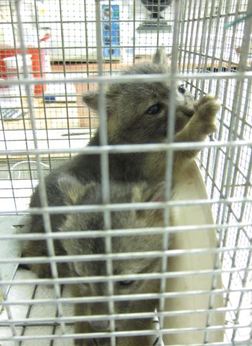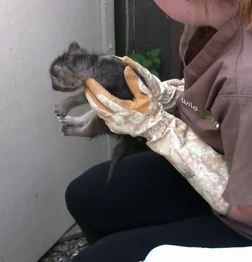
WildCare's Wildlife Hospital treats nearly 4,000 ill, injured and orphaned wild animal patients from over 200 species every year. This is the story of two recent patients.

What she caught surprised her-- two tiny, terrified fox kits.
At WildCare in the spring and summer, we worry constantly that someone will decide to take a "nuisance" animal problem into their own hands and set out a trap.
This time of year, most nuisance animal issues involve mothers with babies, and a set trap all too frequently separates a new wild family. In Baby Season, there's no such thing as a "humane" trap.
The kits arrived at WildCare's Wildlife Hospital on Monday, the day after Mother's Day. Foxes are excellent mothers (and fathers!), and we knew that these kits' mother would be missing them desperately.
As medical staff examined them, they discussed the possibility of returning them to their mother's care.

This made it imperative to get them back to her as soon as possible! Fortunately the homeowner was willing to let us do a reunite and return the babies to their den under the shed in the back yard.
A conversation with our WildCare Solutions expert convinced the homeowner that the foxes wouldn't be interested in her backyard garden, and they would also provide free rodent control of any mice or rats moving through her yard!

Unfortunately, because of Gray Foxes' proclivity for rodents, and their ability to survive and thrive near humans, these animals are some of the more common victims of rat poisoning we see at WildCare. Click here to learn more about how poisoning rodents poisons foxes and other predators.
Home again

Mother's Day came on Monday for this mother fox, when staffers brought these babies back to her den under the shed.
Once on-site, Wildlife Technician Galen Groff gently removed each snarling kit from the carrier and pointed him toward the hole under the shed. Both babies shot down the hole like it was a familiar spot (indeed it was!), and a scan of the den showed it to be a perfect home for the fox family. Watch the video below to see these babies returning to their home.
As of Tuesday morning, there was no sign of the babies in the yard. This is good news, and means their mother must have found them and is keeping them warm and safe. Hungry and cold kits would almost certainly be crying, and probably venturing outside their den in search of mom or dad.
Proper wildlife exclusion
Too often, taking a "nuisance" wildlife problem into your own hands results in a heartbreaking separation of wild mothers from their young.
The story of these two fox kits ended well, but if the baby foxes had been injured in the trap, they would not have been able to return to their mother's care. Even worse, if the mother fox had been trapped instead of the undeniably cute babies, these babies would have been orphaned and may not have survived at all.
If a wild family has made its home too close to yours, sometimes the only solution is to give the babies time to grow up, but rest assured that they will move on in a few short weeks.
Once the family has moved on, contact a professional service that provides "humane exclusion" rather than a regular trapping or pest control company.
The principle behind "humane exclusion" is that the only way to completely eliminate a nuisance animal problem is to eliminate what is attracting the animals.
If you have a cozy spot under your deck that makes a good den site for raccoons, skunks or foxes, these animals will probably move in. If you trap and remove the animal currently in residence, but do not seal up the den site, another animal is almost guaranteed to find the vacancy and take advantage of it. You could trap and kill an endless number of animals and still have the nuisance animal problem, unless you get rid of what attracts the animals in the first place -- in this case, the available den site.
Solving the problem with "humane exclusion" means encouraging the animal to leave on its own (scent and noise deterrents often work best) and then, once no animals are present, especially helpless babies, sealing up the attractive den site. With no den site, there will be no more problems.
Trapping is never the solution to a wildlife problem. Humane exclusion is the only effective long-term solution to a wildlife problem.
Wild animals are drawn to human habitation for three things -- food, water and shelter. If your property provides any of these things, you may end up in conflict with wildlife. Visit wildcarebayarea.org/inspection for a comprehensive do-it-yourself home inspection that will reveal what on your property might be attractive to wildlife. Remember to never seal an entry point without being completely certain that there are no baby animals trapped inside.
Knowing what on your property is leading to wildlife conflicts is a huge step toward solving those conflicts effectively and humanely.
WildCare is a 501(c)3 nonprofit organization supported almost entirely by private donations and individual memberships.
Visit us online at wildcarebayarea.org and help us feed and care for the 30 - 40 Gray Fox patients we admit every year by donating today at wildcarebayarea.org/feedfoxes.
